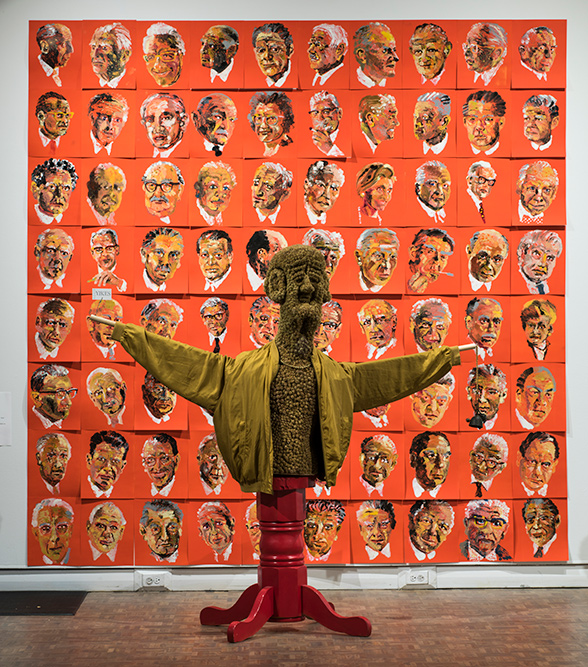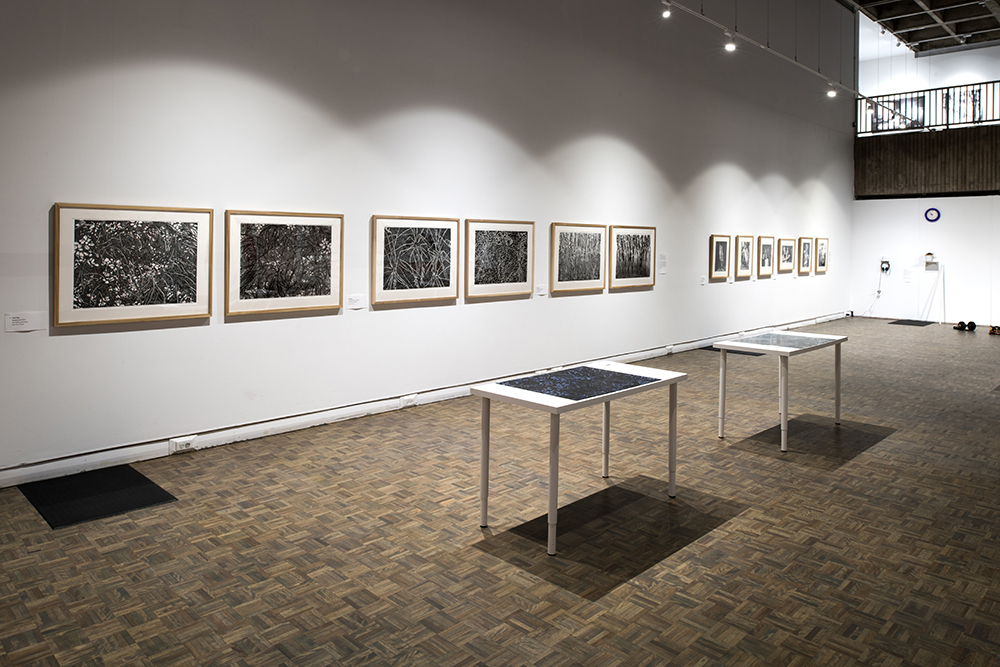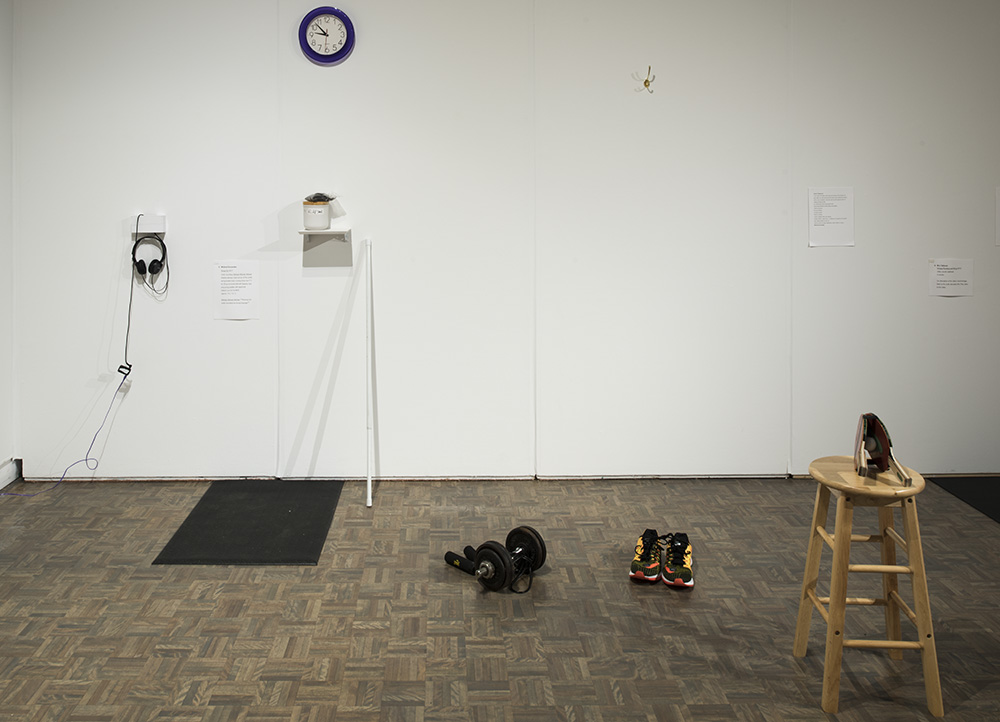Learning Objectives
- To attend to how the aging artists in the Age and Creativity exhibition represent their experiences through their art, and consider how these self-representations can disrupt normative, westernized narratives of aging and ageist assumptions.
- To think with the artworks in Age and Creativity in order to develop an understanding of aging art and how it represents aging vitalities.
- To learn about how aging affects artists’ practices and explore how artists respond to these changes by altering their artistic practices.
- To think through how cultural spaces, such as art galleries, are typically created without aging and disabled artists and audiences in mind, and examine how these exclusions are manifestations of ageist and ableist cultures and cultural values.
- To engage with the Age and Creativity access practices to acquire techniques for curating an accessible art exhibition that anticipates and welcomes aging and disabled artists and audiences.
- To consider how the Age and Creativity exhibition explores themes of aging and creativity and the aging-disability nexus in different ways from how they are articulated in text-based content, such as scholarly articles and policy/analysis of policy. Along with this, to develop an understanding of the integrity of art within rights and social justice activism and movements.
One of Bodies in Translation’s (BIT) key focuses is aging art. Aging art is created by people who identify as aging, of an age, old, older, and/or E/elder. In this section, we introduce the BIT-sponsored and co-curated exhibition, Bodies in Translation: Age and Creativity. We offer learning activities centred around this exhibition that prompt a consideration of how aging arts interrupts ageist and ableist assumptions, and explore the connection between aging and disability experiences. We also explore how the curators of the Age and Creativity exhibition intentionally created spaces invitational to aging people by developing accessible curatorial practices that anticipated and welcomed in aging audiences.
Bodies in Translation: Age and Creativity was a multi-disciplinary group exhibition held at the Mount Saint Vincent University (MSVU) Art Gallery in Bedford, Nova Scotia in the fall of 2017. This exhibition was curated by MSVU Art Gallery’s head curator Ingrid Jenkner, along with BIT researchers and disability curators Lindsay Fisher and Eliza Chandler. The Age and Creativity exhibition featured seven artists from the Atlantic region: Michael Fernandes, Cecil Day, a collaboration between Anna Torma and Illona Klocza, MJ Sakurai, Karen Langlois, George Steeves, and Onni Nordman, all professional artists identified as “older adults” and whose practices engaged, in some way, with the topic of aging.
The curators worked with BIT researcher Katie Aubrecht, who at the time was a postdoctoral fellow at the Nova Scotia Centre on Aging, a research centre at MSVU, and her colleague and the Centre’s director, Janice Keefe. Aubrecht and Keefe curated public-facing knowledge translation events around this exhibition, including an educational panel moderated by Keefe and featured participating artist Michael Fernandes, Bill VanGorder, a representative of the Canadian Association of Retired Persons, Ardra Cole of the MSVU Centre for Arts Informed Research & Teaching, Marcel McKeough, a representative for the Nova Scotia Department of Communities, Culture & Heritage, and poet and activist El Jones, the 2017-2018 Nancy’s Chair in Women’s Studies at MSVU. These events commemorated the 25th anniversary of the International Day of Aging Persons.
BIT makes our past exhibitions publicly available online through digital catalogues, which are interactive websites featuring documentation of artwork, information about accessibility features, artist and curator statements, as well as media coverage and scholarly writing about the exhibition.
Curating Age and Creativity
Building on the knowledge of accessible curatorial practices, documented in BIT’s Vital Practices in the Arts, the exhibition’s curators intentionally created a space that was welcoming, invitational, and hospitable to aging people as anticipated and desired artists and audience members. The curators developed these practices through their analysis of how disabled and aging people have been relegated to certain social institutions, such as asylums and hospitals, and kept out of others, such as art galleries, theatres, and museums. Working with the MSVU Gallery and bringing the exhibiting artists into this process, curators hung the artworks at an accessible height, ensured there was enough space between the works so that a mobility device user could comfortably navigate the space, provided ample and comfortable setting, created an audio description of each work, captioned videos, wrote the object labels (which feature information including titles, artists’ names, and materials used) and didactic texts (which are interpretive texts about an artwork or exhibition created by curators) in clear, jargon-free language, indicated tactile work and work that could be interacted with, and worked with ASL interpretation at all public-facing events.
The curators further adapted and expanded these vital practices to accommodate aging artists and audiences. For example, events featured live captioning in addition to ASL interpretation in recognition that people who have become deaf or hard of hearing through the aging process may not have learned a signed language. Curator Ingrid Jenkner approached the artists early on in their creative process to ask them to think about the different ways that bodies and art interact, and to imagine creative possibilities to make these interactions accessible. In response to this call, printmaker Cecil Day, who recently changed her practice from lithography to linocuts because the process of carving reliefs into the latter was less physically demanding, made one of her prints available as a tactile component for the exhibition. Nonvisual (and visual) audiences could touch Day’s prints to gain an intimate experience of her work that was not rooted in sight, nor reliant on the translation of a sighted person. This accessibility feature, made possible because of Day’s practice shifting with her process of aging, was a delightful surprise to the curators, who hadn’t encountered this enactment of access before. You can read MSVU Art Gallery Director Ingrid Jenker’s overview of the exhibition’s accessibility features in the digital catalogue.
The Age and Creativity Artists and Their Work
The Age and Creativity exhibition featured seven artists from the Atlantic region: Michael Fernandes, Cecil Day, a collaboration between Anna Torma and Illona Klocza, MJ Sakurai, Karen Langlois, George Steeves, and Onni Nordman, all professional artists identified as “older adults” and whose practices engaged, in some way, with the topic of aging.
As Chandler (2017) wrote in her Curatorial Statement on the exhibit, “Together, these works challenged assumptions about aging and explored the lived experience of aging as it relates to identity, culture, embodiment, sexuality and disability.”






Age and Creativity in the Media
Accessible Media Inc. visits Age and Creativity
To get a sense of the visitor’s experience of Age and Creativity, you can watch as Laura Bain from Accessible Media Inc. explores the exhibition through the sensory experience of tactile art.
Interview with Eliza Chandler
This interview with Eliza Chandler featured in CBC Arts explores the exhibition and introduces the concept of “aging arts” in relation to disability arts.
In disability studies, we have the saying that nobody is able-bodied—everyone is temporarily able-bodied, because if you live long enough, you’ll become disabled.

Activity: Nova Scotia Centre on Aging Panel Discussion
The Nova Scotia Centre on Aging hosted a multi-perspective panel on October 30, 2017 at Mount Saint Vincent University’s Art Gallery. Panelists offered insights into how art and art exhibitions can support public awareness of the social and cultural contributions that older adults make to our communities. The Panel was moderated by Dr. Janice Keefe, Director of the Nova Scotia Centre on Aging.
Panelists included:
- Michael Fernandes, artist
- Bill VanGorder, Canadian Association of Retired Persons
- Dr. Ardra Cole, Mount Saint Vincent University Centre for Arts Informed Research & Teaching
- Marcel McKeough, Nova Scotia Department of Communities, Culture & Heritage
Discussion Questions
As you watch the video, consider the question: How do public arts exhibitions challenge assumptions about aging?
Introductory Questions
- What does Bill VanGorder say about the value of art practice for “people of an age”?
- What assumptions about aging and “people of an age” are challenged through the art in the Age and Creativity exhibition?
- What do the panelists say about who decides what “counts” as art?
Advanced Questions
- Panel participant Bill VanGorder, President of the Nova Scotia chapter of the Canadian Association of Retired Persons stated that rather than “older adult” he preferred “people of an age,” a phrase that he viewed as better capturing the fluidity and ambiguity of age. What does this shift in language reveal about normative conceptions of aging? How does VanGorder speak back to these conceptions through the vantage point of lived experience?
- VanGorder also called for recognition of the social and cultural contributions of “people of an age,” opening the possibility of imagining age as more than a number—becoming an encounter, a site of interactional community and collectivity. Reflecting on these comments, can you find examples of artworks from the Age and Creativity exhibition that represents aging as an encounter, a socio-political phenomenon, or a relationalty? Reflecting on the artwork you find in relation to VanGorder’s comments, how can aging art reframe or disrupt normative conceptions of aging?
- How does Marcel McKeough connect artistic expression to freedom of speech? What does McKeough say about the benefits of investing in arts and culture?
- How does Dr. Ardra Cole describe the connection between research, art, and social change?
- What does Dr. Cole say about how art exhibitions might influence and expand our concept of curriculum?
- How do the panelists connect art to wellness and health?
Teaching with Age and Creativity: An Instructor’s Activity Guide
Access in-class activities tailored to different learning levels and disciplines using content from the Age and Creativity exhibition.
Black cursive text on a white background reads, “Bodies in Translation Age and Creativity”.






